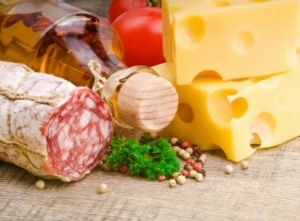
High protein diets do make you lose weight, but at what cost to your health? Heavy cream, whole milk, fried eggs, bacon, pork rinds, beef, cheese, and butter — all these contribute to long-term obesity, cancer, heart disease, diabetes, colon cancer, reproductive cancers, prostate enlargement, autoimmune diseases, and other diseases. [1]
Many types of high protein diets have been revived and are being marketed as a “miracle” diet and “healthy foods”. Nothing could be further from the truth. Animal products contain residual amounts of anti-biotics [what the industry refers to as “Bio-security”]. This term is further explained as the level of drugs that “they” [the meat, dairy, and poultry industry] consider safe levels. There are also residual amounts of anabolic and androgenic steroids within the fat and muscle of the animals and dairy products. [2,25,26, 31]
In addition, high protein diets are moneymaking ploys. Why? Because these diets pray on the desperate individuals that are looking for and guaranteed quick weight loss and make no mention about the potential serious health side-effects of this type of eating regime. Unfortunately, Americans seem to be unaware that they are consuming the very thing they are trying to lose-fat, and lots of it.
There is no doubt that the popular “Atkins Diet”, as well as other high protein, high fat; low carbohydrate diets are popular. These diets make up several of the NY Times bestseller list.
These diet plans are crafted to appeal to the public’s need for shortcuts, and results in the first week. Dr. Atkins informs his patients and readers that carbohydrates (which include fresh fruits and vegetables, fiber and in some cases essential fatty acids- beans, nuts and oils-flaxseed, canola, and pumpkin for example) are making them fat. At the same time he generous amounts of protein and fat will keep them thin. He as well as others neglects to note that having animal fats coursing through our blood makes the blood fat [lypemia], which stays that way for up to four hours. During this time fats actually cover the surface, actually preventing insulin from penetrating the cell to bring any glucose molecules present inside the cell. [3]
Furthermore a diet high in animal protein means more animal fat as well, and that contains the very pro-inflammatory fat [Arachidonic acid] that causes the release of a particular type of hormone that causes inflammatory conditions within the body [arthritis, psoriasis, Crohn’s disease, to name just a few].
These diets also intensify the symptoms of Multiple Sclerosis, PMS and other autoimmune diseases and disorders. [4]
Dr. Atkins insists that all carbohydrates are responsible for high cholesterol levels, obesity and other health problems. He fails miserably to note that there is a difference between refined, beached flours, and refined sugars and whole grains, and lower glycemic index carbohydrates. Atkins further neglects to note that cholesterol only occurs in animal products, and many carbohydrate foods are low in fat, devoid of cholesterol and contain fiber. Atkins’ book sales have risen, as have cattle, egg, dairy, pig and poultry prices. Pork rinds, the one and only fried snack the Atkins’ diet permits, have climbed in popularity by more than 15% in one year. [5]
The numbers of those who have jumped on the high-protein, high-fat kick are staggering, and portend of disastrous health consequences in these individuals in their future. It is a known fact that high protein intake can damage the kidneys and leach calcium from the bones. [6,7, 32]
The lack of fiber disrupts the digestive tract, leading to constipation as water is pulled from the colon to aid the kidneys in diluting the ammonia load that results in the breakdown of animal proteins in the body. [8, 27,28]
George Blackburn, director of the Center for the Study of Nutrition and Medicine at Boston’s Beth Israel Deaconess Medical Center as researched high-protein diets over the years. He points out that there are many annoyingly common side effects: bad breath, fatigue, nausea, dizziness, irritability and lightheadedness. [29] In addition, and somehow conveniently omitted is the fact that when carbohydrates are limited or severely restricted as in the Atkins’s diet muscle mass is digested first, resulting in the quick weight losses that are typically noted in the early stages of the diet.
This occurs in a process known as “gluco-neo-genesis” [the making of new glucose from storage sites-in this case muscle [skeletal, smooth and even cardiac muscle] as well as liver stores of glycogen. You see the brain “eats first”, in other words, the brain requires a continual supply of carbohydrates [in the form of glucose or blood sugar] and oxygen. If this fuel is restricted in the diet [low carbohydrate intake] the brain will look for the easiest source; in this case glycogen stores within the muscle.
As muscle is broken down to liberate glucose, water is also liberated to be excreted and creating a quick and very exciting weight loss on the scale for the unsuspecting, trusting dieter. This creates a cascade of events, including a loss of lean body mass [muscle], a reduction in BMR [basal metabolic rate], or the number of calories your body burns throughout a 24-hour period to maintain homeostasis [balance]. As the muscle is lost, strength is lost with it, as well as the body’s ability to burn calories [primarily from fat] while you are sleeping, working etc. The autoimmune system is depressed as the body is placed under this great “unnatural stress” of consuming proteins at 40-50 percent more than we need, or can properly digest and utilize. [10, 11]
Dr. Atkins had managed to ignore the many population studies, notably the Framingham Heart Study, which has demonstrated that diets high in meat and saturated fat increase risks for heart disease, colon cancer, prostate cancer, diabetes, hypertension, osteoporosis, obesity, and a shortened lifespan. [12] He also ignores the fact that the planet’s thinnest and healthiest humans in the world live in Asia and the Pacific Rim, where rice noodles and other high- carbohydrate foods make up 70 percent of the daily diet. [13]
For the naysayer and supporters of the Atkins’ diet that are quick to claim genetics play a role in the Asians ability to eat this way and not become obese are not staying up to date on the following. When Asians abandon their traditional diets that are high in carbohydrates and fiber and low in fat for foods for the traditional western diet high in protein and fat, obesity and degenerative diseases becomes commonplace. Research studies show that, on average, people switching to a vegetarian diet lose an average of 10% of their body weight. [14]
Indeed, without limiting calories at all, a vegan diet (free of all animal products) trims about one pound per week, and that’s even without getting beneficial exercise and without dodging spaghetti, rice, and bread. Imagine if these same individuals ate these same types of foods in as unrefined a state as possible and added exercise.
Atkins and the other proponents of high protein, low carbohydrate diet would never consider suggesting a vegetarian diet in light of the research of Dean Ornish [Reversing Heart Disease], John MacDougall [The MacDougall Plan] and others. How do these individuals and their toxic diets explain the fact that heart attacks are the most common form of death in the United States, and yet the risk of heart attack for a man consuming a non-meat diet is cut dramatically? [15] Atkins has noting to say about vegetarians having one-third the incidence of colon cancer as meat-eaters? [16]
The American Dietetic Association has called the Atkins Diet “a nightmare”, or that thousands of doctors and dietitians are speaking out against this irresponsible medicine. The work of Michael Klapper, M.D. [Diet for all Reasons], and T. Colin Campbell, Ph.D. [The China-Oxford-Cornell Study] has found conclusively that diets high in protein and animal fat are just plain deadly. [17,30]
Oh, by the way, the Atkins Diet only works when dieters also cut calories. The regimen is a throwback to old low-calorie diets of the 1970s and early 80’s [Cambridge Diet, Medifast Diet, etc.].
They all promised great weight loss, but delivered only temporary weight loss, and long-term health consequences.
Those who are serious about taking off pounds, keeping them off and improving overall health should know that carbohydrates actually boost overall metabolism. Foods rich in complex carbohydrates, such as brown rice, pasta’s [artichoke, spinach, whole wheat, corn, tomato, spelt, barley flours to name a few], fruits, vegetables and beans, nuts, help the thyroid gland burn calories more efficiently.
The adrenal glands are not over-taxed, which calm the Thymus gland, and prevents the lymphatic system from becoming clogged and sluggish. The pancreas works better to maintain a stable blood sugar level, and the colon moves waste matter along its merry way and out.
We as Americans have to take responsibility for ourselves and think of what we are reading and being told. Many of these books use the Inuit Eskimo’s as examples of those individuals who consume a high protein, high fat diet as the shinning example of how the body can thrive in a constant state of ketosis [metabolic acidosis]. Again these authors fail to note that thousands of years of evolution are in place with this race, not to mention the health problems these people endure.
We can live without bogus and potentially dangerous diet plans to lose weight and stay healthy. Following a good, old-fashioned common sense eating lifestyle of keeping fat and cholesterol low [not more than 20 percent of the total calories daily from fat], a diet of fresh fiber-rich foods. Teaching people to eat more in line with the Mediterranean or Asian food pyramid, leaning more about vegetarian foods, and never fear eating good quality unrefined carbohydrates again.
This will lead to better health and less of a fixation about foods and hopefully less stress at least in this part of our life.
Author: Mark J. Occhipinti, Ph.D., N.D.
References:
- Better Bones, Better Bodies, Susan Brown, Ph.D. Keats Pub.
- Hawkey PM. Action against antibiotic resistance: no time to lose. Lancet. 1998; 351(9112): 1298-
1299. - Don’t Drink Your Milk, Frank Oski, M.D. Teach Services, 1996
- Diet for A New America, John Robbins, 1987
- Reclaiming Our Health, John Robbins, HJ Krammer, 1996
- Diet and Disease, E. Cheraskin, M.D., Keats Pub. 1995
- Heart Disease, Alternative Medicine Digest, Burton Godlberg Group, 1998
- Reclaim Your Health, David & Anne Frahm, Penguin Putnam
- Fats that Heal, Fats that Kill, Udo Erasmus, Alive Books, 1993
- The Healing Power of Foods, Michael Murray, N.D. Prima Pub. 1993
- Carmichael, H.A. 1982. Uses of nutritional precursors of Prostaglandin El in the management of
Rheumatoid Arthritis & Chronic Coxsackie Infection. Clin Uses of Essential Fatty Acids. Horrobin, ed.
Eden Press Inc. - Health Eating for Healthy Joints, Mark Occhipinti, M.S., Ph.D., N.D. [candidate] Vermilion Press. 1999
- The New Arthritis and Common Sense, Mark Occhipinti, M.S., Ph.D., N.D. [candidate] Vermilion
Press. 1999 - Health & Fitness in Plain English, Jolie Bookspan, Ph.D., Kensington Books, 1998
- Smart Fats, Michael Schmidt, D.C. Frog Ltd. 1997
- Cancer Battle Plan, David & Anne Frahm, Penguin Putnam
- Antioxidant Revolution, Dr. Kenneth Cooper,Thomas Nelson Pub,
- Reclaiming Our Health, John Robbins, Hj Kramer, Inc.
- Dr. Dean Ornish’s Program For Reversing Heart Disease, Dean Ornish, M.D., Ballantine Books, 1996
- The Healing Power Of Foods, Michael Murray, ND, Prima Pub.
- 8 Weeks to Optimum Health, Andrew Weil, M.D. 1997
- Foods that Fight Pain, Neil Barnard, M.D. 1998
- The Omega Plan, Artemis Simopoulos, M.D. 1998
- Cancer and Nutrition, Charles Simone, M.D. 1994
- Foundations of Normal and Therapeutic Nutrition, T. Randall Lankford, 2nd Edition, 1994
- Levy SB. Multidrug resistance, a sign of the times. N Engl J Med. 1998;338(19):1376-1378.
Glynn MK, Bopp C, Dewitt W, Dabney P, Mokhtar M, Angulo FJ. Emergence of multidrug-resistant Salmonella Enterica serotype typhimurium DT104 infections in the United States. N Engl J Med. 1998;338(19):1333-1338. - Hunter JO. Nutritional factors in inflammatory bowel disease. Eur J Gastroenterol Hepatol. 1998;10(3):235-237.
- Russel MG, Engels LG, Muris JW, et al. ‘Modern life’ in the epidemiology of inflammatory bowel disease: a case-control study with special emphasis on nutritional factors. Eur J Gastroenterol Hepatol. 998; 10(3):243-249.
- Blackburn GL. Functional foods in the prevention and treatment of disease: significance of the Dietary Approaches to Stop Hypertension Study. Am J Clin Nutr. 1997; 66(5): 1067-1071.
- Yates AA. Process and development of dietary reference intakes: basis, need, and application of Recommended Dietary Allowances. Nutr Rev. 1998; 56(4): S5-S9.
- Human Food Safety and the Regulation of Animal Drugs Report, 99th Congress, 1st Session (HR): 99-461, 1985; testimony of Michael Jacobson
- Ursin, G. et. al. Milk Consumption & Cancer Incidence: A Norwegian Prospective Study. British J. of Cancer G1 no. 3, Mar. 1990, pp. 456-459
- Feskanich, D., et al. Milk, dietary calcium, and bone fractures in women: a 12-year prospective study, Am J. Publ Health, 1997; 87:992-7



